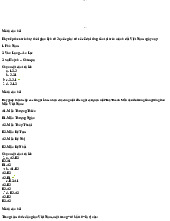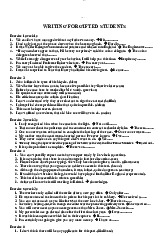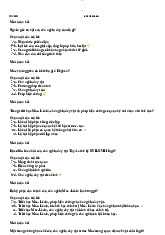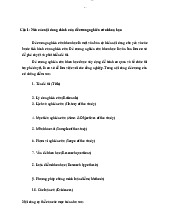







Preview text:
lOMoARcPSD|44744371 lOMoARcPSD|44744371
BASICS OF TRANSLATION - QUESTIONS FOR REVISION
1. How is a message reproduced in translation? Give example to illustrate.
Translating must aim primarily at “reproducing the message.” -
to reproduce the message one must make a good many grammatical and lexical adjustments. -
Translation equivalence is defined as a measure of semantic and structural
similarity between correlated units in the two texts (ST and TT).
Ex: would you like to go to the cinema with me ?
- câu đi xem phim vs mình nhé . -
Finger licking good ( vị ngon trên từng ngón tay )
2. Why must the translator strive for equivalence rather than identity?
Give example to illustrate.
- The translator must strive for equivalence rather than identity to
emphasizing the reproduction of the message rather than the conservation of
the form of the utterance, that equivalence is considered as a relation
between two actual texts and two languages.
Vd: break a leg: chúc may mắn!
Sugar white beach : bãi cát trắng pha lê
3. What is the significance of meaning in translation? Give example to illustrate.
- meaning must be given priority, for it is the content of the message which
is of prime importance in translating. the choice of the right word in the
receptor language to translate a word in the source-language text depends
more on the context than upon a fixed system of verbal consistency.
Ex : dịch từ “chung “ vd như general , common _ hợp tác chung -vấn đề chung lOMoARcPSD|44744371
4. What is the importance of culture in translation? Give example to illustrate. - Cultural sensitivity:
+They have to take into account the culture of the target language
+ In order to avoid misunderstandings, translators have to look out for the lexical content and syntax
- The name of a company or a product, humor, material culture such as names of
food, the style of the language and the target audience, pictures, symbols,
colors, gestures, habits, traditions as well as cultural references are important cultural factors.
Vd: he is a snake : anh ấy là một con rắn
Mà phải dịch là anh ấy rất độc ác
5. What are the differences between interpretation and translation? Translation Interpretation
+is written and transferring a written
+is spoken and conveying a message text. +communication is immediately
+ is a gap and translaters often
+ Interpreters often working in a
spend a long time working on one
team, are faced with people +In
text. +In translation , the translator
interpretation , the interpreter plays the role of a writer . plays the role of an actor
+Reading skill and writing skills are
+Speaking and listening skills very important are very important +Editing skills are necessary.
+ Memorizing skills , coping tactics ,
note taking skills are necessary
6. What is the difference between faithful translation and
semantic translation? Give example to illustrate.
- Faithful translation is a kind of translation:
+to convey the meanings of words and context situation according to the
grammar rules of the target language
+there is some unusuality or unnaturalness in the target language. lOMoARcPSD|44744371
Ex : What I know is nothing. Những gì tôi biết là chẳng có gì. Tôi chẳng biết gì hết
Things go nowhere. Mọi việc đi không đâu. Mọi việc sẽ chẳng đi đến đâu - Semantic translation:
+ Semantic translation focuses to a great degree on meaning (semantic content)
and form (syntax) of the original texts of high status such as religious texts,
legal texts, literature, or speeches.
+ the meaning conveyed by the words by means of word order change or
word choice (synonyms/antonyms) so that the true meaning is conveyed.
Ex: Cost an arm and a leg. Rất đắt đỏ
Bite the hand that feeds you. Ăn cháo đá bát
It rains like cat and dog: mưa như trút nước
7. What is the difference between word for word translation
and communicative translation? Give example to illustrate.
- Word for word translation : focuses mainly on translating words from the
source text into the target language while the word order of the original is preserved.
Ex: I have never seen this film before ( tôi chưa từng xem bô ̣phim này trướcđây )
Bạn đến từ đâu ? Where are you from ?
Beggars asking for momordica rice ( ăn mày đòi xôi giấc )
Hỏi vé : nếu dịch word for word thì là where is your ticket?
Nhưng dịch như vậy sẽ không phù hợp nên phải dịch là : ticket, please!
- Communicative translation: This strategy gives high priority to the
message communicated in the text
+ the actual form of the original is not closely bound to its intended
meaning Ex: dùng để chào đối tác : how do you do ?
8. What is the difference between literal translation and free
translation? Give example to illustrate. lOMoARcPSD|44744371
- Literal translation: is featured by the fact that grammatical structures and the
meaning of words are translated almost as closely as those in the target
language without paying attention to the situation or context.
Ex :tôi có tiết học toán ngày hôm qua với Lan => Lan and I had a Math lesson yesterday.
Tl : nếu dịch theo literal thì sẽ là I and lan nhưng cta nên dịch là Lan and I
- Free translation: focuses more on content than form in the target language;
as a result, sometimes the grammar structure or the form of the words in the target language may change
+ the number of words and the sentence length may vary, depending on the
subjectivity of the translator when he/she adds explanation or comment to make
clear the meaning of the original.
Ex: the film is beyond and words ( bô ̣phim này k chê vào đâu được )
for staff areas ( nếu dịch bthg là khu vực cho nhân viên ) free … cta
sẽ chuyển thành ( khu vực … không phân ̣sự miễn vào)
9. What is the difference between grammatical translation and
semantic translation? Give example to illustrate.( giống câu 6)
10.What is the difference between faithful translation and adaptation
translation? Give example to illustrate.
- Faithful translation tries to convey the meanings of words and context
situation according to the grammar rules of the target language; however,
there is some unusuality or unnaturalness in the target language.
Ví dụ: What I know is nothing. Những gì tôi biết là chẳng có gì. Tôi chẳng biết gì hết
- Adaptation is highly free type focus on socio-cultural phenomena or
practices that are absent in the target culture, rather than on linguistic units. -
Ví dụ : stranger things: cậu bé mất tích
11.How can parts of speech be transformed in translation? Give example to illustrate.
Adjectives can be replaced by adverbs, verbs by nouns, possessive adjectives by
personal pronouns, ... and vice versa lOMoARcPSD|44744371
Ví dụ : - He speaks good English (Cậu ấy nói tiếng Anh rất tốt).
She sing beautifully: cô ấy hát rất hay .
12 How can phrases be transformed in translation? Give example to illustrate.
+A multi-word phrase in English can be rendered as a single-word phrase in
Vietnamese and can be changed in the number of words in the phrase.
+A phrase of one kind in English can be changed in part of speech (noun
phrase is translated as adjective phrase, NP<>VP, AdjP<>NP,
PrepP<>NP, PrepP<>AdvP )
+On sentence function: a phrase can become a clause.
Ví dụ : Những nhà hoạt động vì môi trường: environmentalist
Các nhà sinh vật học : biologist
13. How can clauses be transformed in translation? Give example to illustrate.
+A clause in English can be rendered as a phrase in Vietnamese and vice versa
Ví dụ: I can not understand how he thinks: Tôi không hiểu cách suy nghĩ của anh ta
+A finite clause can be rendered as a non-finite clause in English and vice versa
Ví dụ:Anh ta trở về nhà , rất mệt mỏi : he came home, very tired.
+A subordinate clause can be rendered as a main clause in English and vice versa
Ví dụ: My friend who is very hard working, have found a job: Bạn tôi rất
chăm chỉ và anh ấy đã tìm đươc một công việc .
+A non-defining clause can be rendered as a defining clause in English and vice versa
Ví dụ: Coming back home, he went to sleep.
14 How can cultural words be translated? Give example to illustrate.
Cuture words can be tranlated :
+By the mean of transference : the SL word is brought into the target language text (TLT). lOMoARcPSD|44744371
+By cultural equivalent:this is an approximate translation where a SL
cultural word is translated by a TL cultural word.
+By using componential analysis:SL word is replaced with a more general TL word .
+By using recognized translation:the SL word is replaced with
previously recognized translation of the SL word in the TL.
+By Addition and note:An addition or note is added after the translation of the
TL word or phrase(put in the text in brackets, at the bottom of page or at the end of text).
Example : Tokyo: Tokyo ; kim bap: kim bap
Night club: hộp đêm ; nước mắm: fish sauce
Hai phở bò : two pho
15 How can a proper noun be translated? Give example to illustrate.
1. They can be imported unchanged from the SL text: Canada > Canada;Cuba: Cuba
2. They can be modified to fit the phonological/graphological system of the TL by means of :
(a) Transliteration: (a name is shifted to conform to the phonic or graphic
rules of the TL): Beijing > Bắc Kinh, Moscow > Maxcơva.
(b) Transcription: (a name is transcribed in the equivalent characters of the TL. in
order to keep the readability of the TT: Canberra > Can-bơ-rơ, Myanma > My-an-ma.
3. They can be expanded with a gloss/note to make up for the TL reader's
lack of world knowledge in the target culture either within the text or at the bottom of the page.
4. Re-creation: In some cases, a newly-created name in the ST is recreated in
the TT so that it reproduces the similar effects in the TL such as Mr.
Ollivander that is translated to Sr. Olivares.
5. Substitution: A TL name replaces the SL name, although they are
formally and/or semantically unrelated. lOMoARcPSD|44744371
6. On occasion, they might be omitted altogether (perhaps replaced with a paraphrase)
16What is modulation in translation? Give example to illustrate.
-Modulation consists of using a phrase that is different in the source and
target languages to convey the same idea.
-When the context requires without altering meaning and without generating a sense of awkwardness.
Ví dụ : business is business : công việc là công việc, không xen lẫn tình cảm cá nhân .
For staff only : chỉ dành cho nhân viên, không phận sự miễn vào .
17 What is the reformulation in translation? Give example to illustrate.
-Reformulating means formulating in a different way.
-When a sentence is grammatical but does not appear to make sense even
though the meaning of every word in it is clear.
- Ví dụ : chicken soup for soul : hạt giống tâm hồn.
Frozen; nữ hoàn băng giá
- bãi biển cát trắng phau : a sugar-white beach .
18 How does the translator approach a text for translation?
- The first thing to do is preliminary analysis.
- Next, examine the reasons for choosing the text.
19 How does the translator analyze the text for translation?
When analyzing the text for translation for the first time, the translator needs
to find answers to these questions:
1 What? (what is the theme/topic the text is about?).
2 Why? (what is the purpose of the text writer: to tell, to entertain, or to persuade the reader?).
3Who? refers to the reader of the translated text
4 How? refers to whether the text is written in a formal or informal way
20 How does the translator interpret the source text? lOMoARcPSD|44744371 +Read the text several times
+ Analyse the words (especially key words), the lexico-grammatical
relations within the sentences.
+ When necessary, resolve ambiguity, identify implicit information, interpret figurative senses.
21 How does the translator edit the translated text?
+Takes the form of a careful last-minute checking and correcting of
possible mistakes or other inaccuracies.
+ The translator need revise the draft on the basis of the feedback received from
those people who may have suggested many rewordings, changes, additions or omissions with the translator.
22 How does the translator formulate the translated text?
+ The translator begins drafting the translation piece by piece, section by section
by using the lexis and structures that would make meaningful sentences
functioning in a narrow context as elements of a well -structured text in the target language.
+ Remember that all of verbalizing must be done in the target language .
+ Reformulates the translation according to the grammar rules, word usage,
cultural norms in the target language.



